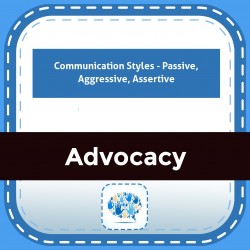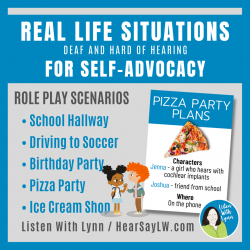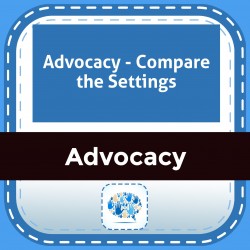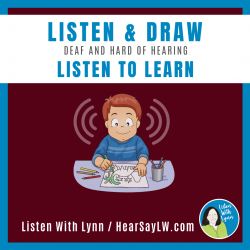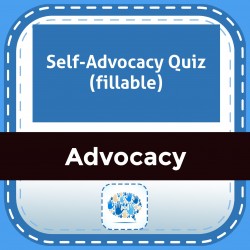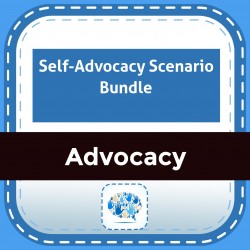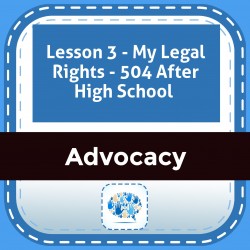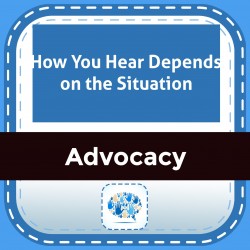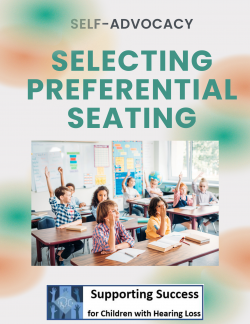Ability Levels
Categories
Resource Types
Age/Grade Range
CCSS
Anchor Standard
Speaking & Listening
Language
Reading
Communication Styles - Passive, Aggressive, Assertive
$ 295
This
packet of instructional materials teaches the advantages and disadvantages of
different communication styles, specifically responding passively,
aggressively, or assertively when you
...
do not understand something that was said. Includes assessments and teaching
materials. From Building Skills for Success in the Fast-Paced Classroom.
Advocacy in Action Curriculum High School
$ 1050
Complete curriculum guidance and scenarios for instruction in the students involvement in IEP planning, understanding and applying the law, assistive devices, and exploring options after graduation (
...
transitioning into the workplace or postsecondary school).
Self-Advocacy Role Play Real Life Connections
$ 7
This Self-Advocacy resource is a favorite of students who are deaf and hard of hearing. There are five situations to role-play where players assume the role of kids at school, at home, with peers, and
...
and in their community. They are all derived from situations of actual kids I've seen for therapy.Self-advocacy success requires knowledge, skills, and most importantly practice. These situations provide opportunities for kids to grapple with challenging situations and explore communication repair strategies within a supported environment. Included:★ Five Scenarios - Two Parts Each1. At School In The Noisy Hallway2. Driving To Soccer3. After the Birthday Party4. Pizza Party Plans5. At The Ice Cream Shop★ Self-Advocacy Coping Strategies:➼ Part One illustrates a communication breakdown when the studentuses Escape or negative strategies.➼ Part Two is the scenario again with the new Take Charge orpositive strategies.★ Talking Points➼ Provided to engage and support a discussion.No-Prep or Planning- For face-to-face sessions and in teletherapyDigital ResourceOptional: Print the role-play scenarios for the students★ Boom LearningThis Self Advocacy For Role Play is also available as a Boom Deck in the Listen With Lynn Boom Learning Store. To use Boom Cards, you must be connected to the internet.◈ ◈ ◈ ◈ ◈ ◈ ◈ ◈ ◈ ◈ ◈ ◈ ◈ ◈ ◈ ◈ ◈ ◈ ◈ ◈ ◈ ◈ ◈ ◈ ◈ ◈ ◈ ◈ ◈ ◈ CUSTOMER TIPS:➼ Questions? EMAIL ME before purchasing this resource or anytime later.♥ Sign-up HERE for the Listen With Lynn Emails♥ Let’s Connect:InstagramFacebookKeep up your good work. I am blessed to help along the way.Thanks so much!Lynn Wood
Advocacy - Compare the Settings
$ 350
What makes a better listening environment? When students can identify factors in their environment that make listening difficult, they are able to better advocate for what they need. These worksheets
...
give visuals and vocabulary to help students understand what makes listening a challenge.
Self-Advocacy Listen & Draw Directions DHH
$ 3
LISTEN TO LEARN is the eighth in the popular Listen & Draw series. These are all auditory imagery activities that target following directions while growing vocabulary, memory and sequencing skills. De
...
etails can be easily simplified or information added to increase the complexity to match the child’s listening and language goals.Children listen to detailed descriptions then follow the directions and draw four different young students all of which are deaf or hard of hearing and use hearing technology. A couple of the kids could be better listeners which is both entertaining and learning opportunities for the kids.Isabella hears with two cochlear implants.Watson hears with two hearing aids.Bryn hears with a Baha® device.Noah hears with a hearing aid in his left ear and a cochlear implant on the right. This LISTEN TO LEARN activity also targets self-advocacy skills. Talking through each scenario will encourage your students to understand the importance of listening to learn and be successful at school.Listening and Spoken Language (LSL) tips are included to encourage auditory learning.
Self-Advocacy Quiz (fillable)
$ 250
True/False Quiz with 4 situational word problems. Students must read situations and respond whether it reflects appropriate student rights, especially with hearing tECH-nology.
Self-Advocacy Scenario Bundle
$ 675
This product contains both of the "Ideal" vs. "Difficult" Listening Scenarios and "Ideal" vs. "Difficult" Listening Scenarios Part 2.This bundle features 30 scenarios that you can use to support your
...
students with their self-advocacy skills. Use these scenarios to discuss problems/solutions that your students may face in a variety of situations.
Lesson 3 - My Legal Rights - 504 After High School
$ 0
Lesson 3 - My Legal Rights When I Leave High School: Section 504 and College. This lesson describes how Section 504 protects students' rights as they move from high school to college. Students will le
...
arn 6 specific aspects of college education protected by section 504 and IDEA. By Kris English.
How You Hear Depends on the Situation
$ 1
How You Hear Depends on the Situation is an instructional worksheet activity in which the student must 1) identify the level of difficulty of listening challenges, 2) provide an example of when they e
...
xperienced such a situation, 3) come up with examples of what they can do in response to the situation and 4) identify what they could ask their teacher, friends or family to do. A good teaching tool or progress monitoring activity after self-advocacy strategy instruction. From Building Skills for Success in the Fast-Paced Classroom.
Self-Advocacy - Selecting Preferential Seating
$ 195
Do students know how to select a seat in different settings? Use this to plan activities for students to determine what is and is not a good place to sit in various situations.
 Your browser is out of date. For best experience switch to latest updated Browser.
Your browser is out of date. For best experience switch to latest updated Browser.
 Get Chrome
Get Chrome Get Edge
Get Edge Get Firefox
Get Firefox